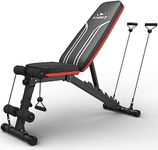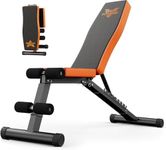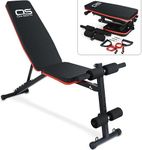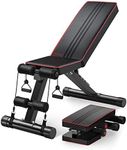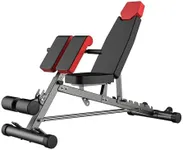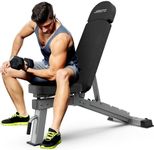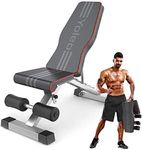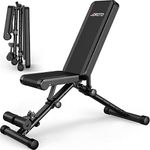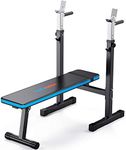Buying Guide for the Best Weight Benches
Choosing the right weight bench is crucial for anyone looking to enhance their strength training routine. A weight bench provides a stable platform for a variety of exercises, helping you to target different muscle groups effectively. When selecting a weight bench, it's important to consider several key specifications to ensure it meets your fitness goals and fits well within your workout space. Understanding these specifications will help you make an informed decision and get the most out of your investment.Weight CapacityWeight capacity refers to the maximum amount of weight the bench can safely support, including both your body weight and the weights you are lifting. This spec is important because it ensures the bench can handle your workout without risk of breaking or becoming unstable. Weight capacities typically range from 300 to 1,000 pounds. For beginners or those lifting lighter weights, a bench with a lower capacity (300-500 pounds) may suffice. Intermediate lifters might look for benches in the 500-700 pound range, while advanced lifters or those lifting very heavy weights should consider benches with capacities of 700 pounds or more. Choose a bench with a weight capacity that comfortably exceeds your current and anticipated future lifting needs.
AdjustabilityAdjustability refers to the ability to change the angle of the bench's backrest and sometimes the seat. This feature is important because it allows you to perform a wider variety of exercises, targeting different muscle groups more effectively. Benches can be flat, incline, decline, or fully adjustable. Flat benches are simple and sturdy, suitable for basic exercises. Incline benches allow for upper chest and shoulder exercises, while decline benches target the lower chest and core. Fully adjustable benches offer the most versatility, with multiple angle settings. If you want a versatile workout, opt for a fully adjustable bench. If your routine is more focused, a flat or incline bench might be sufficient.
Padding and ComfortPadding and comfort refer to the cushioning on the bench, which affects how comfortable it is to use during workouts. This spec is important because adequate padding can prevent discomfort and injuries, allowing you to focus on your exercises. Padding thickness and firmness vary; thicker, firmer padding provides better support and durability, while thinner, softer padding may be less supportive and wear out faster. If you plan to use the bench frequently or for longer sessions, look for one with thick, high-density foam padding. For occasional use, a bench with moderate padding may be sufficient. Always test the bench if possible to ensure it feels comfortable for you.
Stability and Build QualityStability and build quality refer to how solid and well-constructed the bench is. This spec is important because a stable bench ensures safety during workouts, preventing wobbling or tipping. Build quality includes the materials used, such as steel frames, and the overall construction. High-quality benches are typically made from heavy-duty steel and have a solid, stable base. Look for benches with wide, non-slip feet and a sturdy frame. If you are a heavy lifter or plan to use the bench frequently, invest in a high-quality, stable bench. For lighter use, a bench with moderate build quality may be adequate.
Size and StorageSize and storage refer to the dimensions of the bench and how easy it is to store when not in use. This spec is important because it affects how well the bench fits in your workout space and whether it can be conveniently stored. Benches come in various sizes, with some being foldable for easy storage. Measure your available space and consider where you will store the bench. If you have limited space, look for a compact or foldable bench. If space is not an issue, you can opt for a larger, more robust bench. Ensure the bench's size and storage options align with your space and usage needs.
